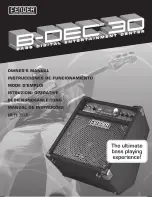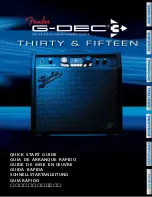
Insider’s Secrets
_____________________________________________________________
16
Versatility
Of course, no preamp or compressor, no matter how well designed, is perfect for all applications or
for all microphones. Fortunately, the 6176 is designed to work with a wide variety of microphones and
signal sources, and we think you’ll find that it acts as the perfect sonic complement for most of
them.
Reviewer Myles Boisen observed in his February 2002 review of the 2-610 for
Electronic Musician
magazine that “the unit can work magic on amplified instruments, electronic keyboards, strings,
horns, and percussion (including wood and metal percussion, alto and tenor saxophones, and trumpet)
and in ambient-miking applications. I also highly recommend it for use with ribbon and other low-
impedance microphones.”
Barry Rudolph reported that “Recording any
instrument or vocal with the 6176 immediately
places that sound source on a proper and wide
stage. The 6176’s ‘personality’ includes tight
and clean low frequencies (if you run the unit
clean) with a very forward and thick-sounding
midrange coloration that’s augmented by the
bright sound of the [limiter/compressor]
section. Percussion instruments benefit from slight preamp overload, reducing ‘spikes,’ while
electric guitars fatten up very well even without the [limiter/compressor] switched in. Using an
external EQ and/or compressor after the preamp stage will get you anywhere else you’d like, but it is
hard to resist not using the unit as is for all recordings!”
Controlled Distortion
The 6176 is more than just a preamp and limiter/compressor; its unique characteristics make it a
tone shaper as well. One of its features is ultra-fast attack and release times, and used correctly (or
incorrectly, depending on the way you look at it), you can use it to add distortion to any otherwise
pristine audio track.
Running most sources through a distortion device can cause the signal to lose some of its definition
as you increase the effect. Also, distortion devices tend to add a significant amount of noise. But
with the 6176, you can compress your signal and add distortion without losing definition, and while
only minimally adding noise. Since the attack and release can happen so fast, set at their fastest
values, they impart minute level fluctuations over the audio. The result is a special kind of distortion
not available through any other means. This distortion can be adjusted to taste by altering the attack
and release times, and by the compression ratio. Of course, you can also adjust the Input control to
set how often the source will go into this distorted compression. Probably the most distorted sound
you’ll get out of the 6176 is in ALL mode, with attack and release set to their fastest times. By simply
backing off on the Input, Attack or Release controls, you can lessen the effect.
If you’re after a compressed grand piano sound with a little edge to it, try routing the signal through a
6176 with Gain of +5 or +10, a little EQ boost at 4.5k, a compression ratio of 8:1, a moderate attack
time (around the 12 o’clock position), and a very short release time. Using the Input knob, dial in 6
dB or so of gain reduction (you’ll need to make up the corresponding amount with the Output knob)
and your piano will take on some unique sonic characteristics you’ve probably never heard before.
“
Recording any instrument or vocal with
the 6176 immediately places that sound
source on a proper and wide stage” —
Barry Rudolph, MIX magazine
















































